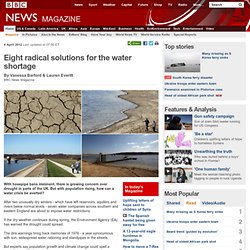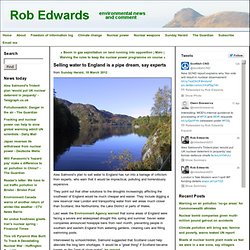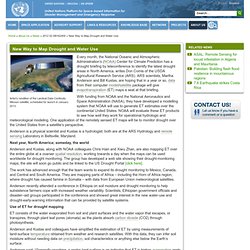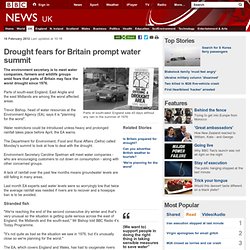

Eight radical solutions for the water shortage. 4 April 2012Last updated at 07:50 ET By Vanessa Barford & Lauren Everitt BBC News Magazine With hosepipe bans imminent, there is growing concern over drought in parts of the UK.

But with population rising, how can a water crisis be averted? After two unusually dry winters - which have left reservoirs, aquifers and rivers below normal levels - seven water companies across southern and eastern England are about to impose water restrictions. If the dry weather continues during spring, the Environment Agency (EA) has warned the drought could spread. The dire warnings bring back memories of 1976 - a year synonymous with sun, widespread water rationing and standpipes in the streets. Continue reading the main story Sound familiar? The so-called Great Drought of 1976 saw reservoirs dried up and turned into giant cracked mosaics of mud. In Dorset, there were 45 days without any rain and for an unbroken stretch of 14 days, southern England clocked up temperatures in excess of 32C. Selling water to England is a pipe dream, say experts. From Sunday Herald, 18 March 2012 Alex Salmond’s plan to sell water to England has run into a barrage of criticism from experts, who warn that it would be impractical, polluting and horrendously expensive.

They point out that other solutions to the droughts increasingly afflicting the southeast of England would be much cheaper and easier. They include digging a new reservoir near London and transporting water from wet areas much closer than Scotland, like Northumbria, the Lake District or parts of Wales. Last week the Environment Agency warned that some areas of England were facing a severe and widespread drought this spring and summer.
Seven water companies announced hosepipe bans from next month, preventing people in southern and eastern England from watering gardens, cleaning cars and filling swimming pools. Interviewed by schoolchildren, Salmond suggested that Scotland could help alleviate the long term shortages. Charles Fishman on our hidden water use. We might not be aware of how much water we use every day. That’s according to Charles Fishman, investigative journalist and contributing editor at Fast Company. Fishman interviewed dozens of water experts around the world for his book, The Big Thirst. New Way to Map Drought and Water Use. Artist’s rendition of the Landsat Data Continuity Mission satellite, scheduled for launch in January 2013.

Every month, the National Oceanic and Atmospheric Administration’s (NOAA) Center for Climate Prediction has a drought briefing by teleconference to identify the latest drought areas in North America, writes Don Comis of the USDA Agricultural Research Service (ARS). ARS scientists, Martha Anderson and Bill Kustas, are hoping that in a year or so, data from their computer model/satellite package will give evapotranspiration (ET) maps a seat at that briefing.
With funding from NOAA and the National Aeronautics and Space Administration (NASA), they have developed a modelling system that NOAA will use to generate ET estimates over the continental United States. NOAA will evaluate these ET products to see how well they work for operational hydrologic and meteorological modeling. Next year, North America; someday, the world. Singapore’s Green-Roofed Marina Barrage Controls Flooding and Stores 10,000 Hectares of Rainwater. Singapore receives 100 inches of rain each year, making flood control and water supply preservation a big issue. The solution: an elegant, low-level dam, known as the Marina Barrage. The Marina Barrage is the nation’s 15th reservoir, but it is the first in the heart of the city. Conceived by Minister Mentor Lee Kuan Yew nearly two decades ago, the Marina Barrage creates a freshwater reservoir that increases the available supply of water and decreases dependence from imported sources.
Together with two other new reservoirs, it has increased Singapore’s water catchment from half to two-thirds of the country’s land area. With a catchment area of 10,000 hectares, the Marina Barrage is one-sixth the size of Singapore. Flood Control. Drought fears for Britain prompt water summit. 16 February 2012Last updated at 10:18.

Drought summit as rivers in England dry up. 20 February 2012Last updated at 13:51 Caroline Spelman, who chaired the summit, says people should start saving water now Environment Secretary Caroline Spelman has hosted a drought summit as parts of England struggle with groundwater levels lower than in 1976.

She invited water companies, farmers and wildlife groups to discuss the situation in south-east England, East Anglia and the East Midlands. Ms Spelman said beforehand the meeting was to work out "preventative measures" that could be taken now. Anglian Water said some reservoir levels are 20% lower then normal. Anglian spokesman Kieran Nelson said: "This year the recharge period started later, it's taking longer and it's going much more slowly. "But we need months of torrential rain, to be quite honest. Continue reading the main story North-south drought divide Richard BlackEnvironment correspondent, BBC News Piping water from wet north to dry south has seemed like a good idea to a long line of people. The water footprint of the world – map. Ec.europa.eu/environment/integration/research/newsalert/pdf/273na1.pdf.
Solve water problems or forget growth, India told. Use it while you have it: Water scarcity is an issue on the horizon - The Parthenon - Marshall University.